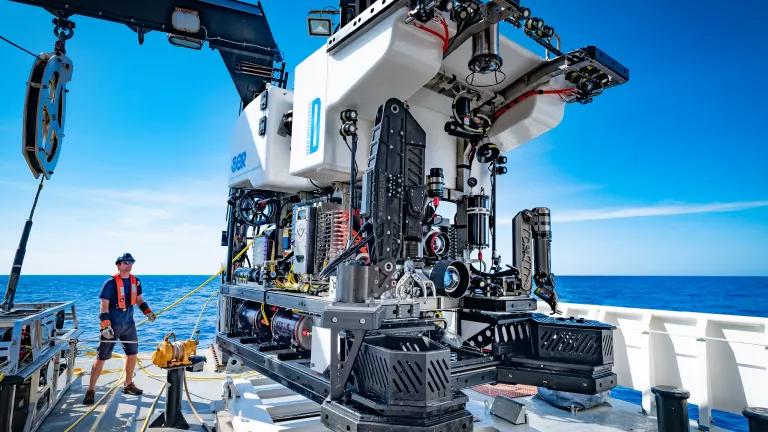
The U.S. has been a global leader in confronting and effectively tackling the overexploitation of its ocean fisheries. While there’s work still be done—more than three dozen fish populations or stocks (out of 233) remain overfished—American fisheries today are among the most sustainable in the world.
Yet, with the job unfinished, the Obama Administration is on the verge of weakening fisheries regulations.
Last month, 44 organizations wrote to the president opposing these rollbacks. The changes would represent the first significant weakening of the country’s ocean fisheries policy since 1996, when important conservation provisions were enacted into law.
NOAA Fisheries, the agency that regulates U.S. fisheries, is proposing to revise the regulations that implement the Magnuson-Stevens Fishery Conservation and Management Act—the nation’s ocean fisheries law—saying that this will give managers more flexibility to handle current fishery management challenges. While flexibility for managers may sound reasonable on its face, that kind of leeway in implementing conservation measures was the exact kind of failed policy that motivated Congress to strengthen the Magnuson-Stevens Act in 1996 and again in 2006. Successful recovery and continued sustainability of our ocean fisheries depends on implementing and enforcing strict catch limits, and helping depleted fisheries recover quickly. Congress saw how managers routinely exploited flexibility, delaying rebuilding efforts and allowing overfishing to continue, and updated the law to put a stop to such behavior.
Congress’s action resulted in significant progress in rebuilding fisheries and ending overfishing. As NRDC’s 2013 Bringing Back the Fish report showed, nearly two-thirds of fish stocks placed in rebuilding plans had been rebuilt to healthy population levels or had made significant progress. By 2015, 39 previously depleted fisheries had been rebuilt to healthy levels. And since 2006, the percentage of federal stocks subject to overfishing has dropped by more than half, from 20% to less than 10%. This impressive progress has been a result of the strong management and conservation policies currently in place.
The changes proposed by the Obama Administration would make overfishing more likely and allow for delay in rebuilding depleted fish populations. For example, managers would be allowed to overfish certain species by grouping them with others. They’d also be able to delay taking necessary conservation action when there’s new scientific information showing a fish population is in trouble. The rollbacks would also allow fish populations to be more easily excluded from any federal conservation and management. (A more detailed list of the proposed rollbacks can be found here.)
These changes purportedly will make it easier for regions that are failing to meet current standards to comply. Why is that a good idea? Regions where existing regulations have generally been robustly applied—such as the North Pacific, Pacific, and Mid-Atlantic—now have largely sustainable fisheries. But other regions—New England, the South Atlantic, and the Gulf of Mexico—have routinely made riskier decisions. They have not seen the same progress.
Atlantic cod in New England, for example, has been depleted and experiencing overfishing for literally decades. That has resulted in lost jobs and fishing operations. Weakening the rules to appease poor performers betrays the nation’s commitment to achieve healthy ocean fisheries.
Easing back on recovery has major economic fallout. In 2011, NOAA Fisheries estimated that rebuilding all U.S. fish stocks that year would have generated $31 billion more in sales, supported 500,000 more jobs, and increased the fishermen’s revenue at the dock by $2.2 billion.
This is why more than 100,000 people commented that the proposed rule was going in the wrong direction and should be fixed. It’s also why members of Congress sent a letter expressing concerns that the proposed rule is inconsistent with Congress’s intent to end overfishing and rebuild overfished fisheries. They wrote that the rule could “erode the hard work, investments, and sacrifice our fisherman and constituents have made to put U.S. fisheries on track for long-term sustainability.”
NRDC and its allies have asked for the proposed rule to be fixed or withdrawn. Now is not the time to lower the bar for strong fisheries management. Beyond the economic implications of easing up on recovery standards, allowing fish populations to be managed at the edge of sustainability is an extremely risky approach, at a time when climate change introduces new threats to fisheries that managers are only beginning to understand. The Obama Administration should extend its focus on tackling climate change to our ocean fisheries. It should ensure that fisheries are managed to build and sustain fish populations that are resilient to warming waters, changing ocean chemistry, invasive species and other threats brought about as a result of climate change.

It has taken a lot of work to put our nation on the path to sustainable fisheries. The policy framework currently in place helps ensure that this will not be squandered and we’ll continue to see gains. Staying the course by keeping, and building on, our current standards will reap ecological and environmental benefits for our nation. That’s a legacy anyone could be proud of.




